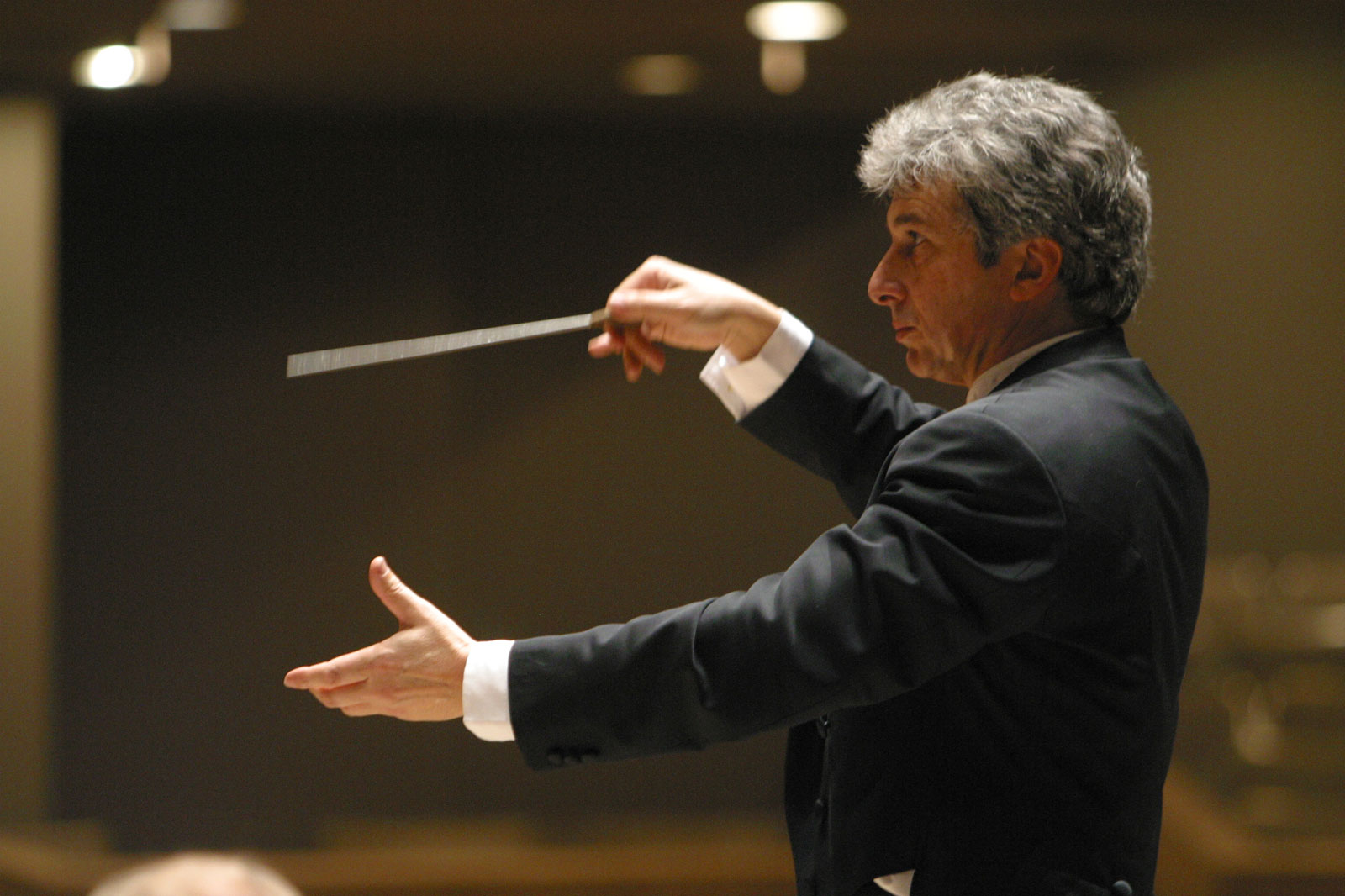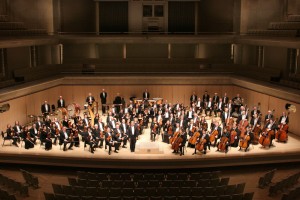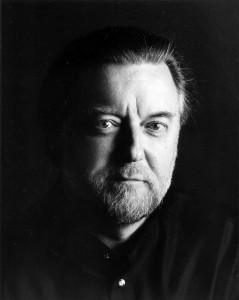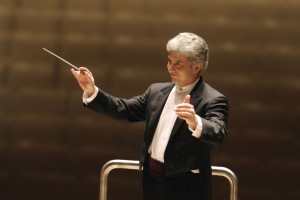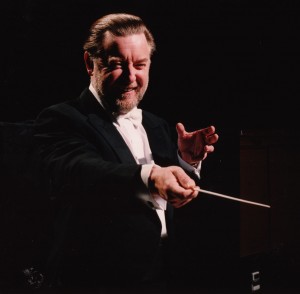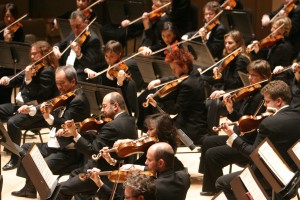Toronto Symphony Orchestra
The Toronto Symphony is in the middle of what may turn out to be one of the great comebacks in orchestra history. Although it had a long history, a distinguished list of former music directors, a large discography, and a home city that is to Canada what New York is to the US, it came very close to folding in 2001. Its return from the brink is a story with lessons for many orchestras.
The Toronto Symphony Orchestra is the largest, and by some measures the oldest, orchestra in Anglophone Canada. The first orchestra calling itself the TSO was formed in 1890, although a semi-permanent version had to wait until 1906. That orchestra featured many world-renowned guest artists, including violinists Fritz Kreisler, Eugène Ysaÿe, Carl Flesch, and the 17-year-old Mischa Elman; pianists Wilhelm Backhaus, Vladimir de Pachmann, and Sergei Rachmaninoff, and Sir Edward Elgar conducting his oratorio “The Dream of Gerontius.” Unfortunately, this orchestra did not survive the economic hardships of the First World War.
1923 saw the rebirth of the TSO as the “New Symphony Orchestra” (which name was changed in 1927 back to “Toronto Symphony Orchestra”), with the musicians receiving a fee of $3.95 per concert. The orchestra became the first orchestra nationally broadcast across Canada in 1929 with a series of 28 broadcasts from the Arcadian Court restaurant in the Simpson’s department store in downtown Toronto.
The orchestra’s modern history began with the appointment of Canadian conductor and composer Ernest MacMillan in 1931 (the last Canadian music director of the TSO until the appointment of Peter Oundjiain in 2003). MacMillan programmed far more contemporary music than had his predecessors (including the local premieres of the Sibelius symphonies), and in fact Holst’s The Planets became the most-repeated work during his tenure and the first work recorded by the TSO. He also introduced considerable numbers of Canadian works.
The TSO’s first international tour was to the US in 1951 and became the cause of a major public dispute, when the orchestra fired six musicians who had been refused entry to the US on unstated grounds. The case of the “Symphony Six” caused much bad press for the orchestra, which unfortunately did not lead to the musicians’ reinstatement or even the support of their local union (although one, Steven Staryk, returned many years later as concertmaster). MacMillen, who was criticized for not having taken a position on the matter, eventually resigned in 1955, and was replaced as music director by Walter Susskind.
March 2008
Susskind introduced the concert performance of opera to TSO audiences, as well as conducting the first Toronto performance of Stravinsky’s Sacre du printemps and local premieres of works by the Second Viennese School. He also invited a prominent list of conductors to guest-conduct, including Sir John Barbirolli, Sir Thomas Beecham, Malcom Sargent, and William Steinberg.
The TSO’s first near-death experience came early in Susskind’s tenure. The Toronto audience was becoming more diverse, the benefactors who had funded the MacMillan years were dying off, the musicians’ relationship with their local union was acrimonious, and government funding was not yet a major part of the Canadian arts scene. This all culminated in a labor dispute in 1961 that delayed the start of the orchestra’s season and led to the departure of the orchestra’s manager since 1934, J. W. Elton (who had succeeded his father as orchestra manager) and the hiring of Walter Homberger in 1962. Homberger’s 25 years with the TSO was to make him a legendary figure among orchestra administrators.
Homberger was born in Germany in 1924 but left prior to World War II and became a Canadian citizen in 1942. He founded the premiere arts management and concert presentation firm in Canada, International Artists Concert Agency, in 1947. IACA sponsored Canadian concerts by virtually every major soloist, as well as many European and American orchestras.
Homberger’s tenure brought marked improvement to the TSO’s fortunes. Susskind was replaced in 1965 by then-wunderkind Seiji Ozawa in his first major Western orchestra position. Although Ozawa was only with the TSO until 1969, his tenure was marked by a significant increase in ticket sales, tours to Europe and Japan, extensive performance of contemporary repertoire, and an increase in the season from 30 to 42 weeks of employment. The orchestra also made a number of recordings with Ozawa, several of which are still in the catalog.
Ozawa was replaced by the Czech conductor Karel Ancerl. During the Ancerl years the orchestra continued to record while also adding both outdoor summer concerts at Ontario Place and a Pops series. Ancerl was to have led the orchestra in a European tour in 1974, a plan derailed by his untimely death in 1973 at the age of 65.
Ancerl was replaced by the young English conductor Andrew Davis. While the orchestra continued to record (although now for Columbia) and tour internationally, the major event during Davis’ tenure was the move from 19th century Massey Hall to a purely orchestral venue, Roy Thompson Hall, in 1982.
Walter Homberger retired in 1987 with the ultimate going-away party, the so-called “Great Gathering” on March 9, 1987. This concert, which featured the Toronto Symphony in concert with just about every major artist on the planet, raised $2.3 million for the endowment fund. (As an example of the magnitude of star power on display that night, one short segment of the program featured the last movement of the Brahms G minor piano quartet with Murray Perahia, Isaac Stern, Pinchas Zukerman, and Mstlislav Rostropovich.)
Whether or not by coincidence, the orchestra’s fortunes began to go downhill after Homberger’s departure. Davis departed in 1988 and was replaced by Gunther Herbig, initially as artistic advisor and then music director. Herbig’s tenure was almost as short as Ozawa’s; he announced in 1990 that he would be leaving at the end of the 92-93 season (although he ended up staying an additional year).
Major-label recording projects had dried up, new international tours did not materialize, and the orchestra began running a chronic deficit. The appointment of the young Finnish conductor Jukka-Pekka Saraste as music director in 1994 seemed to have little effect on improving the orchestra’s economic condition.
In marked contrast to the stability of Homberger’s tenure, managers came and went with confusing rapidity in the 90s. Wray Armstrong, Assistant Managing Director to Homberger and his designated successor, lasted until 1991, when he was replaced by Max Tapper, who came to Toronto from the Winnipeg Symphony. Tapper’s tenure marked the first salary giveback in the orchestra’s recent history, with a 15% pay cut in response to a projected deficit of $3.5 million. Despite this, the accumulated deficit continued to increase, no doubt a factor in Tapper’s decision to return to Winnipeg in 1995.
Astonishingly, a permanent replacement for Tapper was not hired until 1998, when Catherine Cahill was hired – and lasted a year before returning to New York.
The TSO musicians, unhappy with the fact that the cuts taken in 1992 were never really restored, went on strike in 1999. The strike lasted for over two months, finally coming to an end before Christmas of 1999. The strike received very little attention locally; the Toronto Globe and Mail reported 3 weeks into the strike that they had received only 5 letters on the subject. Nonetheless the eventual settlement was one that produced significant raises for the orchestra.
In April 2000, Music Director Jukka-Pekka Saraste announced he would be leaving at the end of the 2000-01 season. 7 months later, the TSO board finally filled the vacant executive directorship by hiring Ed Smith, who came to the TSO after running the City of Birmingham Symphony Orchestra for 21 years – much of that time during Simon Rattle’s tenure as music director there.
Smith’s hiring was widely hailed as a coup. He lasted less than a year, saying upon his departure in September 2001 that “the internal culture of the organization is probably beyond repair.”
There is no doubt that things did not go well for the TSO during his tenure. The most visible sign was a very public attempt to fire the TSO’s principal cellist, Daniel Domb, for having performed with a small amateur group while recovering from a fractured skull suffered during a fall. While Domb was reinstated after an appeal to an internal peer review committee, the initial termination and Domb’s subsequent lawsuit for damages incurred a great deal of negative publicity for the orchestra.
The day after Smith’s resignation, TSO board chair Robert Weiss said that the orchestra would face bankruptcy in the absence of an immediate cash infusion.
Several events then happened in close succession. The musicians agreed to further concessions of about $1 million per year in salary, money from the Toronto Symphony Foundation was made available, and former Ontario premier Bob Rae, one of Toronto’s best-known and most widely respected political figures, joined the restructuring committee. He soon became chairman of the TSO board, putting together a $4 million government-sponsored rescue plan and hiring Andrew Shaw to be the orchestra’s CEO.
Shaw had been a cellist with the Royal Winnipeg Ballet before managing several smaller Canadian ensembles and then running, came to the TSO from a major Canadian music publishing house. He lost little time in filling the position of Music Director with Canadian violinist and conductor Peter Oundjian, whose appointment was announced in January 2003.
Frank Morphy, a long-time member of the TSO oboe section and the current chair of the orchestra committee, attributes much of the turn-around to Shaw:
Andrew is our #1 fan. He’s done a remarkable job. He’s cleaned up the office and was the one who brought Peter here, which has certainly been a good thing from the standpoint of audience development. Ticket sales have been on the increase. Everyone in the office is working their tails off. We can all see it.
One thing that’s been important is that Andrew gives a monthly meeting with the orchestra. At first it was just a presentation; now he’s been bringing in entire departments to explain what they did, so we would get to know what the individual staffers do. He’s brought a unity to the organization, but particularly he’s brought in good staff, especially in building a real professional development department. He had to convince the Toronto Symphony Foundation (the endowment) to change their governing documents to help us do that and to borrow $5 million. So in the last few years there have been several major endowment gifts, although changes in tax law (to make stock contributions tax-deductible) helped also.
The last two seasons we’ve finished in the black (last year with a $500,000 surplus), even though there was a board-approved budget that provided for a deficit. In both years, an anonymous donor made up the difference, which allowed us to make a dent in the accumulated deficit of around $9 million.
Another major challenge facing the TSO was its hall. Roy Thompson Hall is a very attractive and well-sited venue, but acoustically it was a total disaster. This was recognized pretty early on (in fact Saraste was promised that it would be fixed when he was appointed), but it was not until late 2000 that a plan was approved, and it was not until after a 22-week shutdown in 2002 that the renovated hall finally reopened.
Apparently it was worth the wait. According to Frank Morphy,
The renovation of the hall has been huge. There was no bass response and the sound was very distant. There’s big bass response now and you can hear much better.
The Toronto Symphony is hardly out of the woods. It is carrying a very large accumulated deficit and is trying to develop an audience in what might be the most ethnically diverse city in North American. But the success of the past five years, and its newly-found stability in key leadership positions, offer grounds for optimism that the TSO will continue to be an orchestra of international stature.
An interview with Cathryn Gregor, TSO Acting Chief Operating Officer
Cathryn Gregor: Andrew Shaw (TSO President & CEO), having completed 5 years, is on a much-deserved sabbatical. That’s why I’m here, for a temporary period, so that he can have a sabbatical and then come back and do another five years.
Robert Levine: So you came in as an interim CEO?
Cathryn Gregor: Yes; my title is acting chief operating officer. I’m here for one year and Andrew is gone for six months of that one year. So we overlapped for three months, he was gone for three months, back for three months, then he’ll go away for another three months, and then my contract comes to an end.
Robert Levine: It’s a very interesting arrangement; I’ve never heard of one quite like it.
Cathryn Gregor: When the crisis happened 5-6 years ago to the TSO, the board was looking for a way to keep an executive director for longer than had been the case. The turnover in EDs caused its own problems. So when the board was searching in 2001 for the next CEO, they wanted to structure a contract that would encourage someone to stay for a longer period of time. They might have assumed that would take the form of a bonus for success. But when they asked Andrew what he wanted as a bonus, he asked for time off if he stayed for five years, and they agreed to that.
Andrew structured his sabbatical in a very responsible way, so that the board and staff felt comfortable, both with the degree of orientation that I received and also that he was only gone for three months at a time. When he’s back in February through April, we will begin negotiations for a new master agreement, finalize the budget for next season for the board’s approval (although we’ve done a lot of work on it in his absence). Then he’ll go away again for three months.
Robert Levine: How did you get involved with the TSO?
Cathryn Gregor: I had done a similar job at the Canadian Opera Company. I was there soon after Richard Bradshaw arrived during the time we built the orchestra into a real full-time group. I had also been tour manager at the TSO about 17 years ago for about 18 months, and had worked for other cultural organizations such as museums and festivals, so I had a pretty good generalist background. …We’re all envious of Andrew’s sabbatical.
Robert Levine: The only other example I know was when Peter Pastreich took a six-month sabbatical from running San Francisco.
Cathryn Gregor: I’m sure he needed it; the work is very intense. There are hundreds of people you’re dealing with and the hours are very long. It’s just a killing number of hours. But in Canada organizations are just a little too thin to allow it.
Robert Levine: I noticed that the TSO seemed to have a small staff compared to comparable US orchestras.
Cathryn Gregor: There are still people here who remember when Walter Homberger ran the orchestra when a staff of four, and they wonder why we need so many now.
Robert Levine: He sounds like a remarkable man.
Cathryn Gregor: A complete professional, He still attends every concert, and is still really involved. In fact he’s James Ehnes’ manager, although he’s been in the process of passing James on to someone younger in New York.
Robert Levine: You must have an interesting perspective, being involved now but not so involved in the recent past. What do you see as the biggest challenges for the TSO over the next five years?
Cathryn Gregor: One of them is the immediate financial challenge. The TSO has balanced its budget for the last two years, and looks to do so this year, but it’s still extraordinarily difficult to do that. I’ve heard someone describe it as trying to land a helicopter on a frying pan. It’s really tough to know that you’re going to have the revenues to cover the expenses that you’re committed to and know they’re coming in on target. It’s not as difficult to control expenses, but it’s really hard to control revenue.
So the strategy is to build up the Foundation, the TSO’s endowment fund, so that it can make larger annual grants to the organization and eventually provide for growth. It’ll be a really big challenge to go from the current $23 million, which for an American orchestra of our size would be a ridiculously small amount. The TSO would like to triple or quadruple the value of the endowment.
Robert Levine: Will that be a particularly big challenge for a Canadian orchestra? The endowment mentality doesn’t appear to be as rooted up there as it is in the US.
Cathryn Gregor: People here aren’t used to giving the kinds of sums that are required to enable the endowment to grow quickly enough. It’s a completely different history here, although it’s changing, at least in Toronto. There have been a lot of capital projects; universities and hospitals are very conscious of the US fundraising model, and there have been lots of big cultural projects, like the new opera house and the Royal Ontario Museum. All those projects have changed how people go after philanthropy and have broken down barriers with donors.
So people are starting to give in record amounts. The TSO recently had a $5 million gift, a $2 million gift, and a $1 million gift, which were the three largest gifts in our history. We haven’t announced a formal campaign because we wanted to reach a certain level before we did, and also because there are so many ongoing campaigns in Toronto for capital projects that seem more glamorous right now. But I think we’re getting to the time we can do that. Three years of balanced budgets have given donors the confidence to participate.
Along with that is the challenge of managing expectations within the organization; how much growth or enrichment is possible within that period of time. When people hear that you’ve had a $5 million gift, they’d like to spend it. There are many projects the TSO would like to do, and there’s been a period of restraint here for a long time. So people are impatient for a little bit more prosperity to do the kinds of things that we’ve talked about doing and are important to do.
Next season we’re going to Carnegie Hall for the first time in many years. But we have no international touring planned, and only a modest recording project this year (with the support of the Canada Council). It’s a CD and download project using the new AFM live recording agreement. The first recording will actually be in our hands in a few days. That’s an exciting moment for the orchestra. But it’s still a fairly modest project, and although I know that Peter wants it to continue, it will only do so if we can continue to fund it.
We have no radio archives, so we had to hire the engineers and pay for the recording costs. We don’t record every concert; we picked a dozen from this season; orchestra only, no soloists, and public domain repertoire.
The other challenge I think we have for the next 5 years is community engagement and public awareness. I think it was a big shock to the musicians, when the orchestra was in severe trouble, that the city didn’t rise up in support of the organization. The TSO had been inward-looking, and although very busy with concerts and many educational concerts, a lot of it was invisible except to the immediate participants. There didn’t seem to be a lot of public consciousness or a feeling that the city really needed the orchestra. So the TSO is going through a strategic planning process this year for the first time in a number of years. It hadn’t been done for the past 5 or 6 years because the problems were so fundamental that it didn’t take much planning to figure out what had to be done to keep the orchestra alive.
But, now that things are stabilized, the organization felt the need to pause and think about what the next 5 years should look like. In particular the chair of the board, Ana Lopes, who is a fantastic fundraiser and has brought a lot of new people into the fold of the TSO, felt the need to understand what the story of the TSO would be going forward. In order to raise the kind of money we want to raise for the endowment, we need to tell people what that money will allow the orchestra to be to the city of Toronto, rather than simply tell people it will allow us to balance our budget. We had to have a more compelling story about what support will enable us to do. That’s what we’re trying to find over the course of this year.
Robert Levine: I recall from working in Canada that the problem of finding effective boards is even worse than it is in the US, some of which I’ve attributed to the fact that there’s a fair amount of government funding; not enough to keep the doors open but enough to discourage boards from being effective fundraisers.
Cathryn Gregor: We are between the worlds of European orchestras, which are civic organizations, and the US, where orchestras receive little government funding. We’re a hybrid, and that’s not a bad place to be actually. But it’s true that the culture of philanthropy is different here. The tax laws are different too, although there was a recent change that allows individuals to donate stock and receive a tax write-off. That has made an enormous difference in the willingness of people to give. As a direct result, that’s how we got the three large gifts, and we regularly get gifts of stock now. It’s made a big different to the whole non-profit sector.
So things are changing gradually. I don’t think we feel discouraged about it. We’re happy to have government support at the level we’ve had it, because we believe that it’s a public good and a good use of taxpayer money to have some level of support for orchestras. But it won’t take us everywhere we want to go.
Robert Levine: I saw that you have a website in Mandarin.
Cathryn Gregor: We do, and we also have customer service people who speak Mandarin and Cantonese, because we have an enormous Chinese population here in Toronto. Many of them have come here with an interest in Western classical music because of their background and education. 5% of our audience is now Chinese, from Hong Kong as well as Taiwan and mainland China, so we need to be able to serve them in Mandarin and Cantonese, although many of them are fluent in English and don’t require it. But some do, and others just like the idea.
We’re also working with ticket brokers in the Russian and Korean communities, which, while not as large as the Chinese community, are still of significant size here. They’re a good target audience for us, so we advertise in their papers and prepare materials in those languages. I know that our marketing department wants to have a Russian section on our website.
Robert Levine: I don’t think anyone in the US is doing that, and I don’t know why.
Cathryn Gregor: Toronto is a remarkable city in that way, being so hospitable to so many different ethnic groups. Toronto is now 50% visibly minority populations.
We see the differences when we go to the American conferences. US orchestras are dealing with primarily the Hispanic and African-American minority groups. Here we have dozens of minority groups that we can focus energy on.

